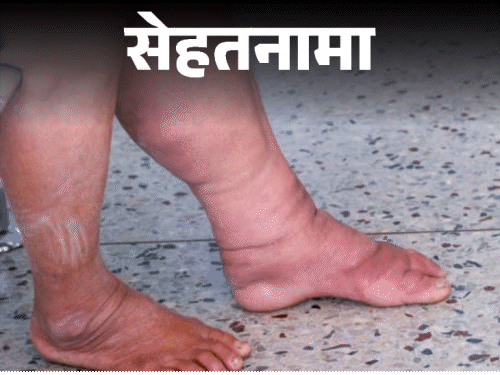14 minutes agoAuthor: Gaurav Tiwari
- copy link

India has made significant progress in combating lymphatic filariasis (filariasis) in the last few years. Recently, the National Center for Vector Borne Disease Control (NCVBDC) launched a Mass Drug Administration (MDA) campaign targeting 63 districts in 6 states to combat the disease. The aim was to surpass the 82.5% coverage rate achieved in the year 2023.
Filaria is an infectious disease, which is spread through mosquito bites. Due to this, fluid retention can occur i.e. fluid can accumulate in any part of the body. In many cases it can even lead to deformity or disability.
The organ affected by this disease swells and becomes heavy. Generally, due to this the size of the foot becomes very heavy. This is the reason why it is also called elephantiasis or elephant foot disease. In common parlance people call it filariasis. At present, 74 crore people of India are at risk of filariasis.
so today ‘medical certificate‘I will talk about filariasis. You will also learn that-
- What are the symptoms of filariasis?
- How does this disease spread?
- What are its treatment and prevention measures?

3.1 crore people in India have filariasis
According to a report published in the Indian Journal of Public Health, about 74 crore people of India are at risk of filariasis, while 3.1 crore people are infected with it. Of these, about 2.3 crore people are symptomatic, that is, symptoms are visible in their body. There are a large number of people who are infected with filariasis but do not show any symptoms in their body. Despite this, his lymphatic system and kidneys are getting damaged.
Why do hands and feet become larger when there is filariasis?
- Lymphatic system is an important system of our body.
- It removes excess water from the tissues and returns it to the blood stream.
- It creates a kind of white blood cells, which protect us from diseases by fighting germs.
- It absorbs fat soluble vitamins and proteins from the digestive system and sends them into the blood stream.
- It transports waste products from our blood. The kidney removes it through urine.
- The lymphatic system helps in keeping blood pressure under control.
Due to malfunction of this system the immune system starts weakening. The tissues start filling with water. Due to this, the risk of infection and allergy increases and due to increase in swelling in the infected organs, their size starts increasing.
What are the symptoms of filariasis?
Dr. Pankaj Verma, Senior Consultant, Department of Internal Medicine, Narayana Hospital, Gurugram, says that in most of the cases of filariasis, no symptoms are seen. This means that most people are asymptomatic.
Some people infected with it show mild symptoms, while 1 in every 3 people have severe symptoms. In this, hands, legs or face become so heavy that it takes the form of disability.
What are its symptoms, see in the graphic.

Which organs are affected by filariasis?
According to the Centers for Disease Control and Prevention, filariasis affects many organs. This has a bad effect on the kidneys. Apart from this, hands, feet and skin are also affected. Our immune system is also affected by this.
Dr. Pankaj Verma says that the main cause of filariasis is parasites. These gradually damage our lymphatic system. First it affects the internal organs. That’s why nothing is known in the beginning. When the infection increases greatly, its effects start appearing in the external organs of the body also.
Due to this, what kind of changes occur in which organs, see in the graphic below.

What are the complications caused by filariasis?
The biggest complication in this disease is that our immune system becomes weak. The body is unable to fight minor allergies and bacterial infections. Every small and big disease starts affecting you.
Apart from this, inflammation caused due to accumulation of fluid in the tissues is also a big problem.

Filariasis is caused by parasitic worms. These worms very slowly reach the lymphatic system through the blood stream. There an adult parasitic worm lives for 7 years. It produces millions of parasites during this period. Their numbers increase very rapidly. Therefore it becomes difficult to treat.
What is the treatment for filariasis?
Dr. Pankaj Verma says that in case of filariasis infection, its treatment is more or less easy in the initial days. Its symptoms can also be prevented from becoming severe, but it becomes difficult to treat as time passes. The problem is also that its symptoms are not visible in the initial days. Therefore it becomes a lifelong disease.
In its treatment, medicines Albendazole, DEC and Ivermectin are given.
Take precautions if you have filariasis
Dr. Pankaj Verma says that if someone has filariasis, he should make some improvements in his lifestyle, so that bacterial infections and allergies can be avoided and life can become easier.

What are the ways to avoid filariasis?
The best way to avoid filariasis is to avoid mosquito bites. Since the risk of filariasis is very high in India, we need to take special precautions.

………………………… Read this health related news also
Sehatnama- Trachoma eliminated from India: It is the biggest cause of blindness, 8 suggestions from eye specialist

According to the World Health Organization, trachoma is still a major health problem in 39 countries of the world. Due to this, 19 lakh people across the world have lost their eyesight. Therefore, complete eradication of this disease from India is a huge achievement. Read the full news…



